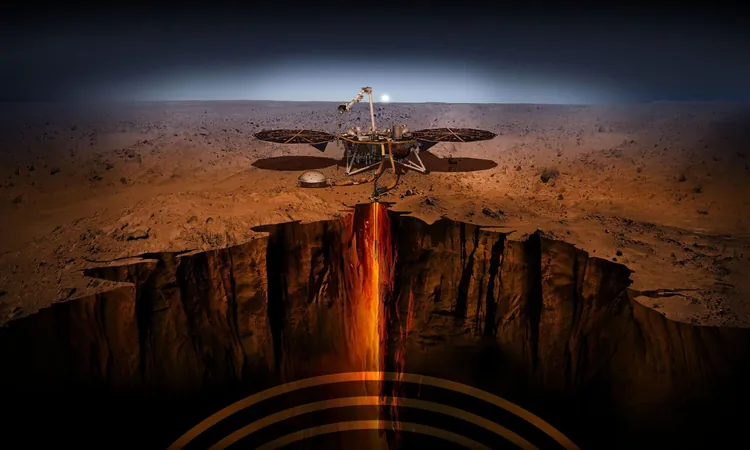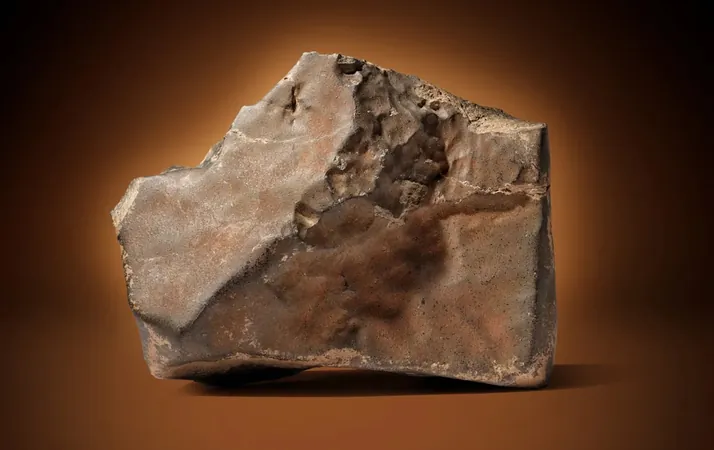
Why is Martian Soil So Crusty? Scientists Reveal Shocking New Insights!
2024-11-05
Author: Emily
Introduction
NASA's groundbreaking InSight mission, which touched down on Mars on November 26, 2018, has opened up a treasure trove of information about the Red Planet. Never before had a research station been deployed to probe Mars's interior, making this a monumental achievement in the history of space exploration.
The Martian Mole's Journey
Equipped with the innovative Heat Flow and Physical Properties Package (HP3), or the Martian Mole as it's affectionately known, InSight aimed to dig deep—up to five meters (about 16.5 feet)—to measure the heat emanating from the planet's core. However, the ambitious plan didn’t go as smoothly as hoped. The Mole struggled to burrow through the Martian surface and was only able to reach just beneath the crust, falling short of its major objectives. Yet, it gathered vital data on the temperature changes beneath the surface over time.
New Insights on Martian Soil
Recent analysis conducted by a team from the German Aerospace Center (DLR) has shed light on a surprising reason behind the hard, crusty texture of Martian soil. The top 40 centimeters (around 16 inches) of Martian soil experiences intense temperature variations that lead to the formation of salt films, effectively hardening the top layer into what scientists have called "duricrust." This dramatic revelation was published in the esteemed journal, Geophysical Research Letters.
Geological History of Mars
But the story doesn't end there! The revelations about Martian soil go hand in hand with our understanding of the planet's geological history. Scientists believe that geological activity on Mars halted around 3 billion years ago, during the late Hesperian period, but intriguing evidence suggests that lava may still flow beneath the surface. This ongoing activity could be tied to how Mars's lower mass affects its internal pressure, leading to rapid cooling and changes in its core dynamics.
Thermal Observations
InSight's team measured thermal conductivity and heat transport, revealing that the density of the upper soil layer resembles basaltic sand—an unexpected finding. This sand-like material is commonly formed on Earth through volcanic processes and is rich in iron and magnesium. Interestingly, scientists found that beneath this sandy layer, densities corresponded to consolidated sand and coarser basalt fragments.
Mechanical Properties of Martian Soil
Tilman Spohn, head of the HP3 experiment at DLR, elucidated the mechanical properties of Martian soil through an unusual analogy, comparing it to floral foam—lightweight and porous but capable of maintaining its structure under pressure. He noted, "Over seven Martian days, we observed unique temperature measurements, documenting daily and seasonal temperature fluctuations for the first time."
Temperature Fluctuations
The data indicated that ground temperatures fluctuated only slightly—between 5°C and 7°C (9°F to 12.5°F)—compared to the extreme temperature variations on the Martian surface, which can soar to as high as 130°C (266°F)! Moreover, seasonal shifts were observed up to 13°C (about 23.5°F) in layers close to the surface, reinforcing the idea that Martian soil functions as an excellent insulator.
Implications for Future Exploration
This unique thermal behavior influences numerous physical properties, affecting how materials interact beneath the surface and potentially giving clues to the speed at which seismic waves travel through the ground. Spohn concluded by highlighting the implications for future human exploration, stating, "Temperature influences chemical reactions in the soil and interactions with the Martian atmosphere, crucial for understanding potential microbial life."
Conclusion
Mars continues to be a planet full of mysteries, and this latest revelation regarding its crusty soil could pave the way for future explorations, not just for rovers, but for humans too. Stay tuned as we delve deeper into the secrets of the Red Planet!









 Brasil (PT)
Brasil (PT)
 Canada (EN)
Canada (EN)
 Chile (ES)
Chile (ES)
 Česko (CS)
Česko (CS)
 대한민국 (KO)
대한민국 (KO)
 España (ES)
España (ES)
 France (FR)
France (FR)
 Hong Kong (EN)
Hong Kong (EN)
 Italia (IT)
Italia (IT)
 日本 (JA)
日本 (JA)
 Magyarország (HU)
Magyarország (HU)
 Norge (NO)
Norge (NO)
 Polska (PL)
Polska (PL)
 Schweiz (DE)
Schweiz (DE)
 Singapore (EN)
Singapore (EN)
 Sverige (SV)
Sverige (SV)
 Suomi (FI)
Suomi (FI)
 Türkiye (TR)
Türkiye (TR)
 الإمارات العربية المتحدة (AR)
الإمارات العربية المتحدة (AR)